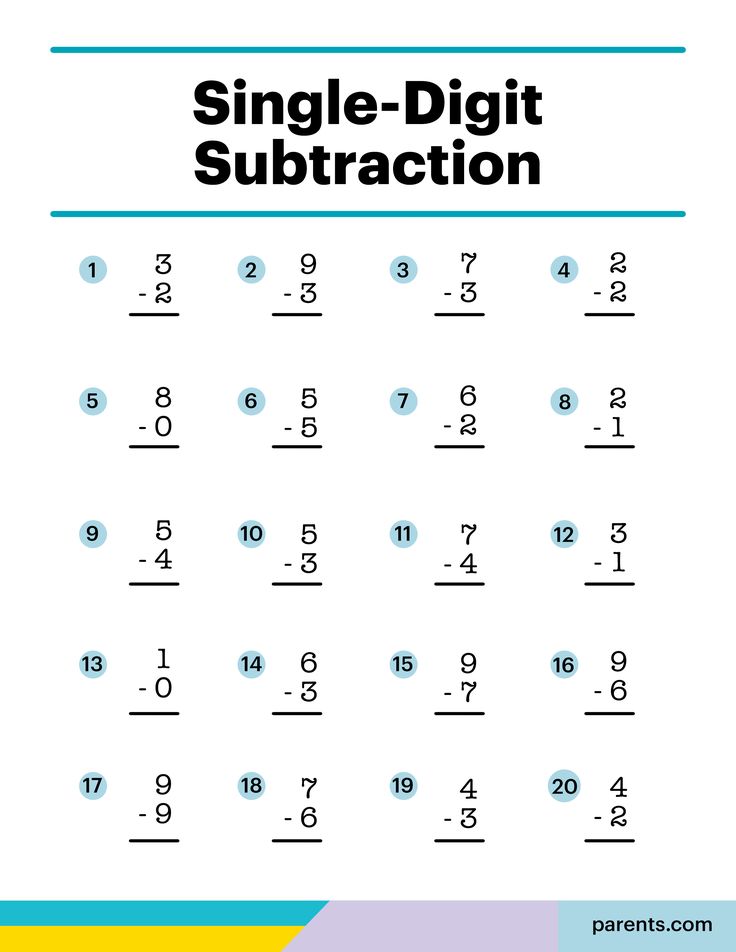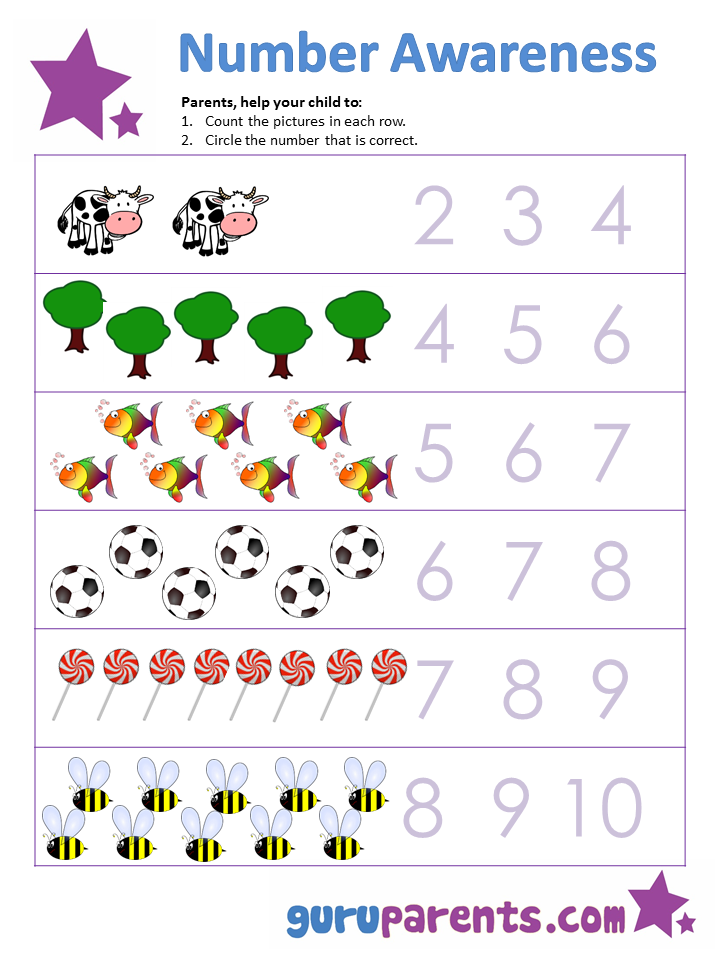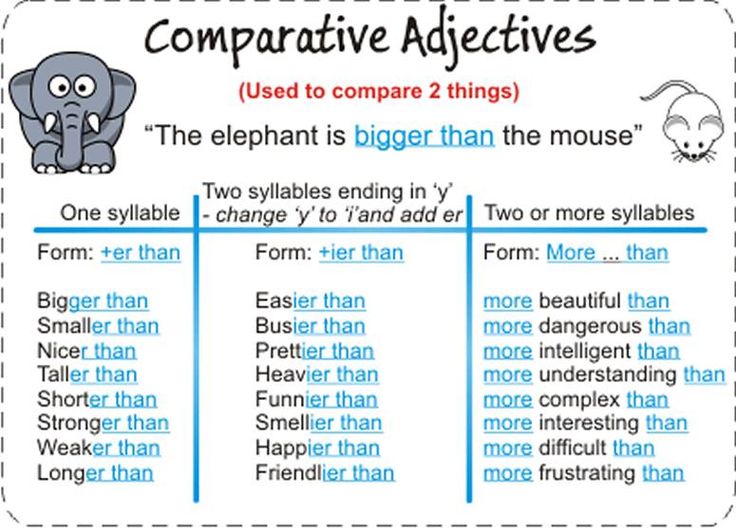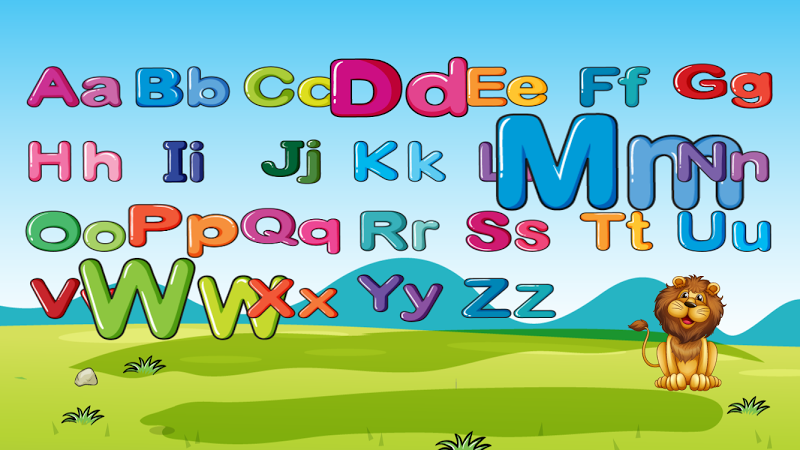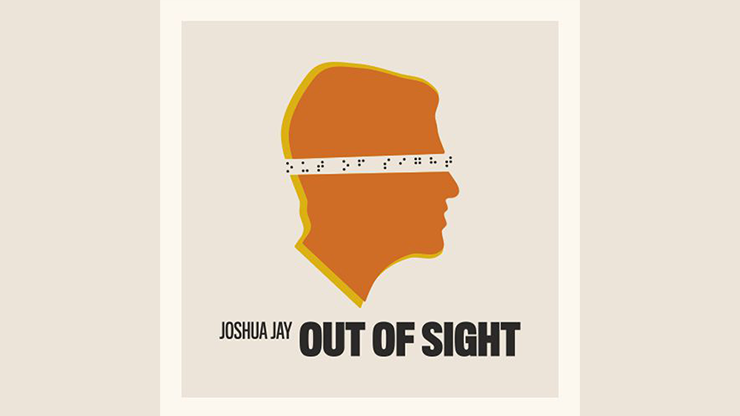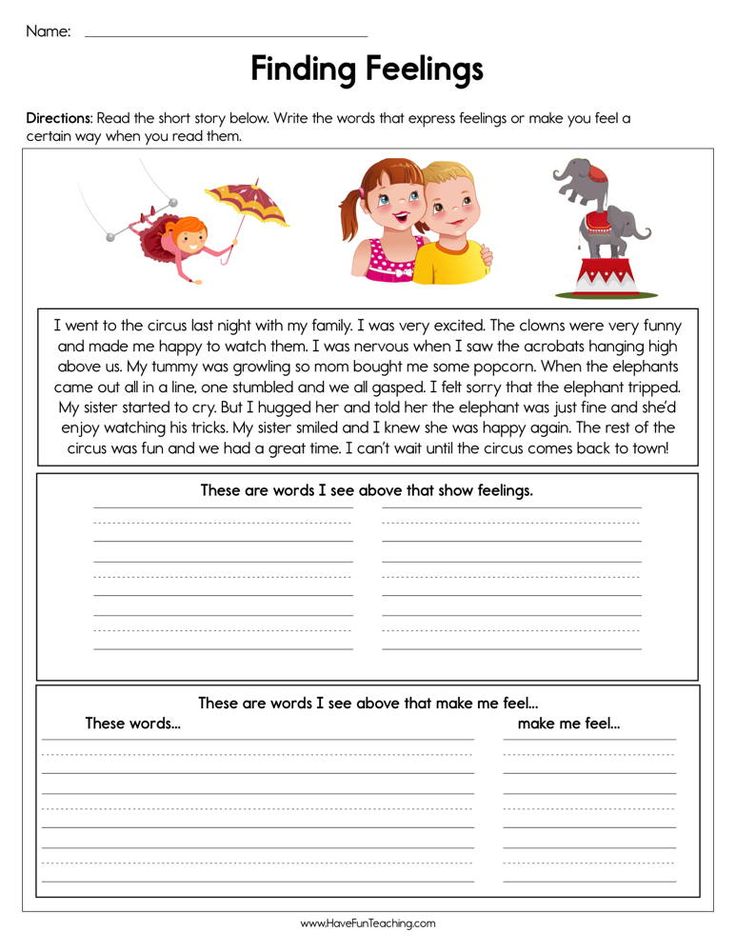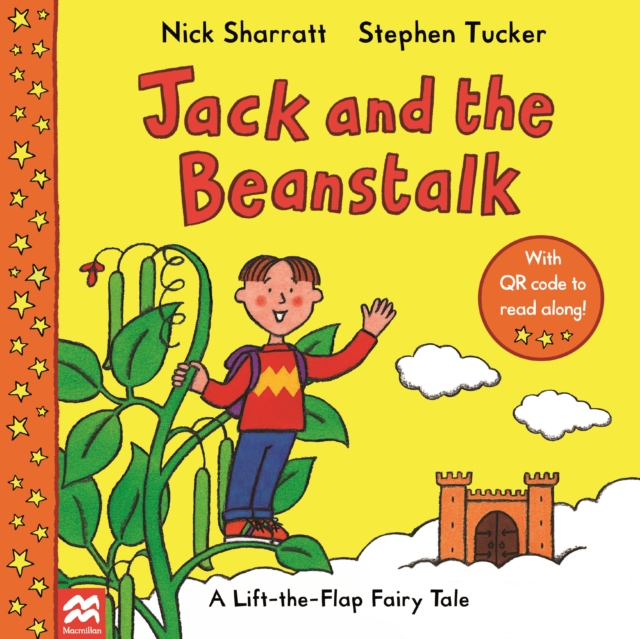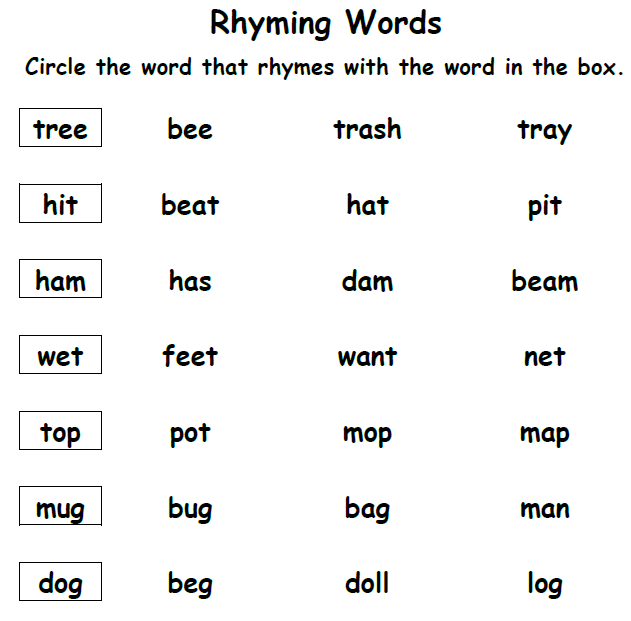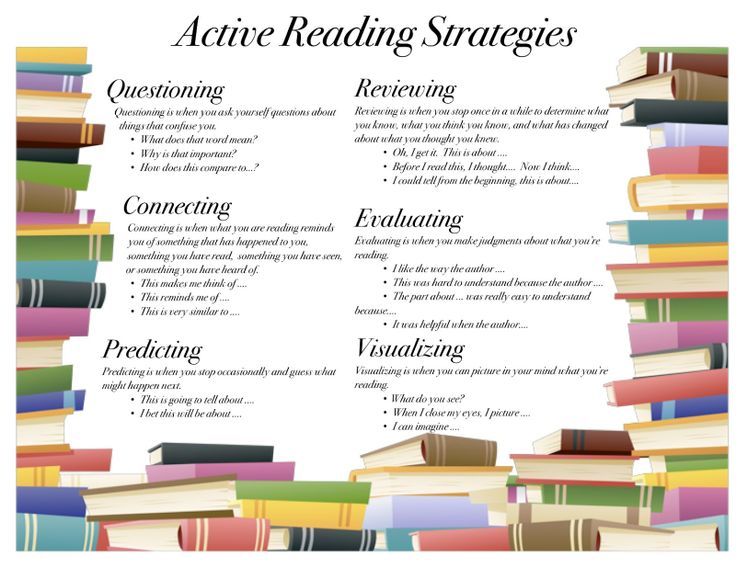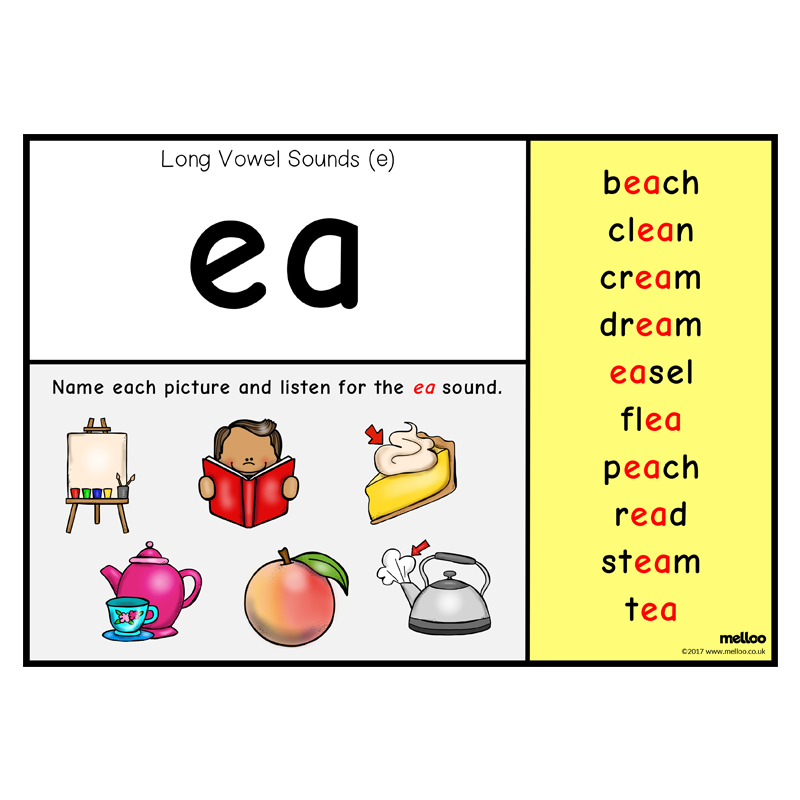Subtraction for first graders
Subtraction Games for 1st Graders Online
Importance of Subtraction
Children have many daily experiences with addition and subtraction which they often do not realize. They should be provided with experiences of fun mathematics activities, learning games and strategies to understand how to add and subtract. There are so many such opportunities throughout the day, when adding and subtracting strategies involving math word problems can be solved and taught. These learning opportunities need not be initiated only at the school in the classroom rather these experiences can be initiated as and when they arise in our day to day situations. For example, while reading a story, or setting the table, cooking a meal, climbing the stairs, putting away the toys, cleaning the room, coloring a picture and so on.
It is always recommended to begin with addition to teach children these strategies and fun activities. Once children develop strong conceptual understanding of addition only then should one introduce how to subtract. Many activities used for teaching addition and be used to teach subtraction too. But some learning activities must be conducted to explicitly teach children the inverse relationship of addition and subtraction.
Math aids and manipulatives and mathematical tools help children to visualize and solve problems in hands-on ways. These fun mathematical activities and strategies provide children with ample experience to remember and apply these to solve addition and subtraction worksheets. These strategies will also help in real-life problem solving.
Children spend maximum time being home or with their parents. Hence it is important to understand the complexities involved in learning subtraction so that they can be taken care of. To begin with, the simple mathematical equation or statement 5-3=2 has a multiplicity of meanings. For example, the number 5 could mean so many different things. 5 may denote 5 objects, 5 groups of objects, the position of number 5 on a number line or just the abstract number 5. Same is the case with numbers 3 and 2 in the equation. Thus, the statement is a generalization of many different types of 5s, 3s and 2s in different contexts. So, asking a child what is 5-3 equal to is a very bizarre statement if no context is given.
Same is the case with numbers 3 and 2 in the equation. Thus, the statement is a generalization of many different types of 5s, 3s and 2s in different contexts. So, asking a child what is 5-3 equal to is a very bizarre statement if no context is given.
In addition to this, the complete statement 5-3=2 is also a generalized statement which can represent many different situations. For example
- Jack had 5 candies but Jill took away 3 of those, 2 remaining with Jack
- One plant is 5 cm tall and the other is 3 cm, so the difference in their heights is 2cm
- John had $5 and he spent $3 for buying a toy, so he ended up saving $2
Thus, to preschoolers or 1st graders the mathematical statement 5-3= 2 often has little meaning when no context is given. As a result, all addition and subtraction word problems in the early years must be done through kids learning games and activities that involve the children themselves. The activities for kids should be engaging and such that the context is entirely apparent.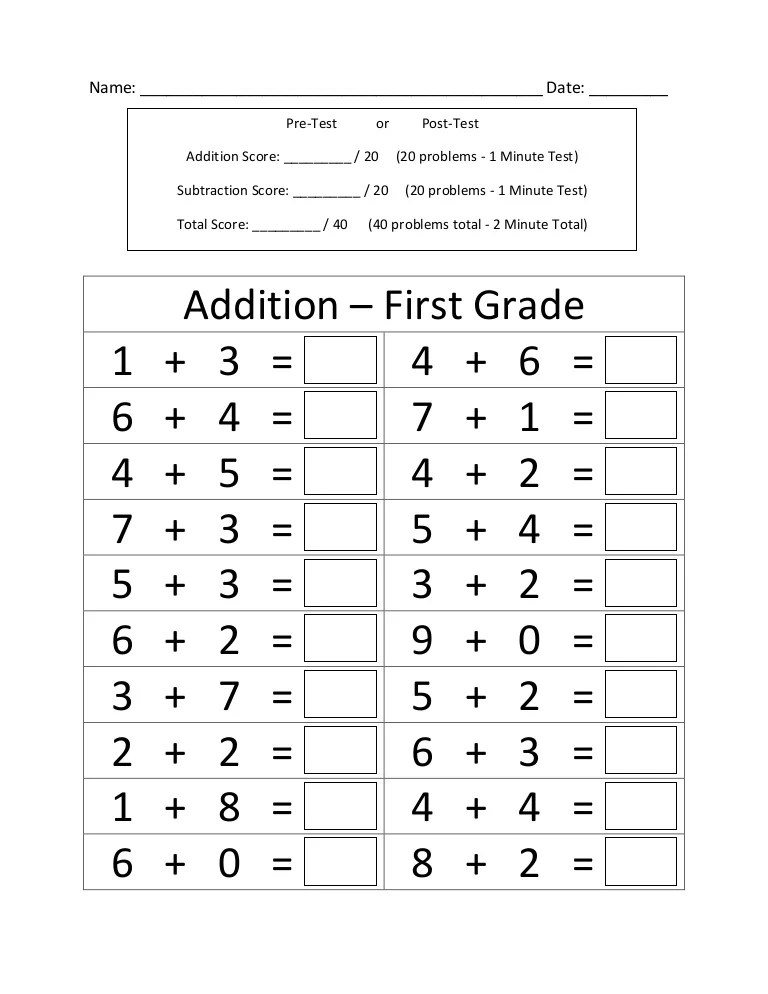 Also, pictorial representation in math worksheets should be encouraged to develop conceptual clarity and grasp over subtraction definition.
Also, pictorial representation in math worksheets should be encouraged to develop conceptual clarity and grasp over subtraction definition.
Subtraction Activities for Grade 1
First grade kids are taught the concept of ‘taking away’ or subtraction through a number line. Kids learn how to count back to subtract.
In this learning method, a number line is used. Kids move back on the number line one at a time as much as the number that is to be subtracted. The number on which the kid ends up is the answer of the subtraction problem.
For example: Solve 5 – 2
In the number line method, children start at 5 and take away 2. Hence, they land up on 3 which is the required difference.
To generalize this procedure, always start from the minuend (the number from which something is taken or the number you subtract from) and move back as many steps as the value of subtrahend (the number which is subtracted or is to be taken away). The final position one ends up on gives the difference of the two numbers.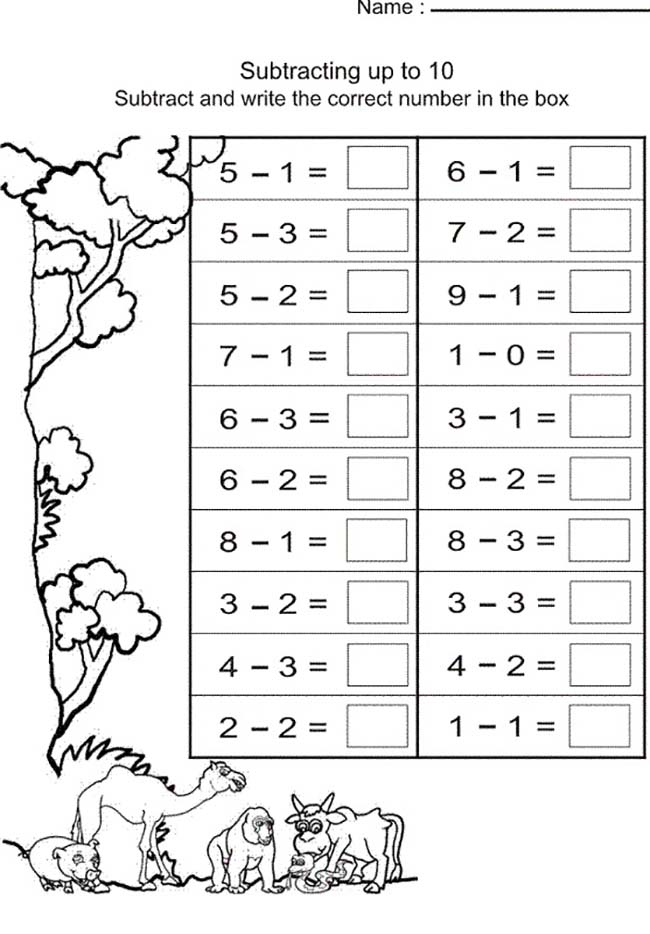 Thus, we can define subtraction as the difference between two numbers.
Thus, we can define subtraction as the difference between two numbers.
There are many interesting activities and educational games for kids around the number line theme to teach them subtraction.
- Subtraction worksheets with a context provide children the motivation to solve subtraction problems. In this case the context of bugs is given. For example: Mark caught eight ladybugs in the backyard and he let go four of them. How many are left?
Kids can answer this on the number line created and then write an equation for the same.
- Lego blocks are perfect math aids that can be used to teach subtraction on number line. They are one of the best fun games for kids that are super easy to understand. Combine the blocks together and number them using a pen. Take any counter and you are ready to go. Give instructions to your kids and see him happily following the same without getting bored.
- If giving instructions is a task and you do not have all that time then try doing this math activity.
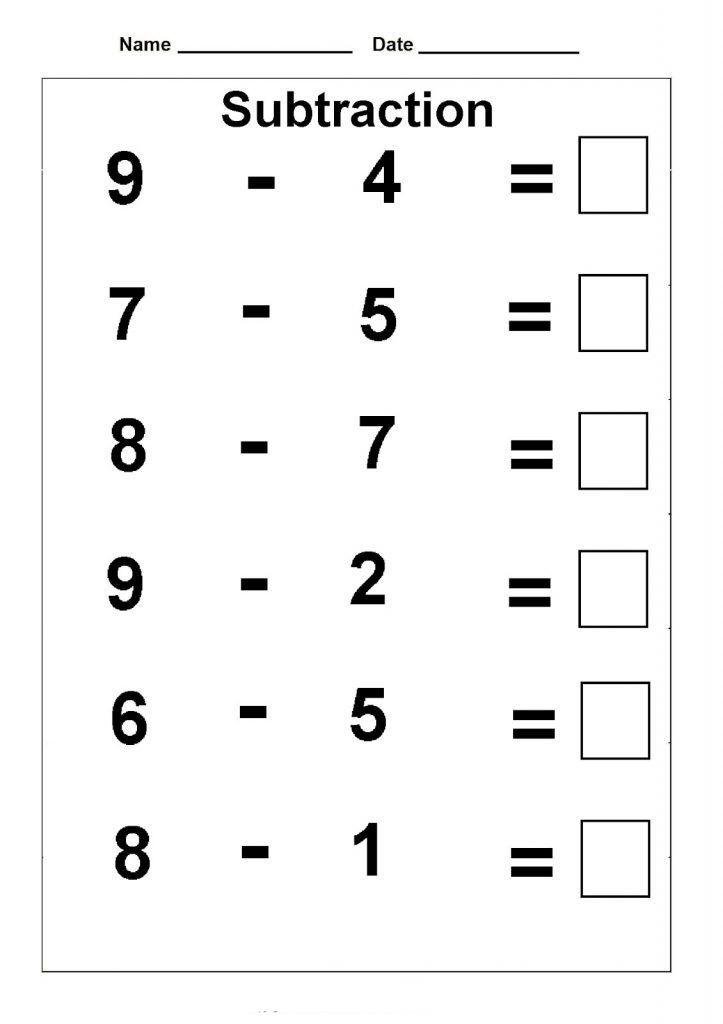
Write all the set of instructions in strips of paper. Punch them and compile them together with a key chain. Now either make a number line on the floor using tape and let kids follow the instructions being the counter themselves, or use the lego block number line or simply a drawn number line on a sheet of paper and a cute counter to move with.
- Subtraction flash cards with written set of instructions is another cool way to get kids involved into practicing number line method for doing subtraction problems.
- For kids who enjoy doing more than following a set of instructions try the squish number line activity. In this activity, instead of moving their counter forward and backward kids get to squish the number line balls made from clay- dough. Grade one students are expected to perform subtraction within 10 using their counting skills. This activity can work wonders for that!
1st Grade children are also expected to understand the relationship between addition and subtraction.
First and foremost, shall be to introduce subtraction as inverse of addition. This can be achieved through a simple and effective math subtraction worksheet as follows:
At the top are five jars in a cupboard whose doors are open: three at left and two on the right. This picture illustrates the equation: 3 + 2 = 5. ‖
In the next picture, the left-hand cupboard door is closed, hiding the three jars. Only two of the five jars can be seen. This picture illustrates the equation: 5 − 3 = 2. ‖
The bottom picture shows the left door open and the right door closed, hiding two jars and illustrating: 5 − 2 = 3. ‖
The quantity of five jars and the arrangement of the jars is the same in all three pictures. The only change in the pictures is the closing of different doors. The equation, however, changes from an addition equation to two subtraction equations. The changes in the three pictures and their accompanying equations reveal for children the relationship between addition and subtraction. Addition is to find the sum of two known addends and subtraction is to find an unknown addend when the sum and one addend are known.
Addition is to find the sum of two known addends and subtraction is to find an unknown addend when the sum and one addend are known.
When seeing a subtraction, and not knowing the solution, one only needs to think- ‘What number when added to the subtrahend yields the difference?’‖Very clearly, if one knows addition that is let’s say: 3 + 2 = 5, then one can extrapolate: 5 – 3 certainly must be 2 and 5 – 2 certainly must be 3
Some addition and subtraction games and activities to help kids understand their relation better are as follows.
- Kids must understand that addition is commutative but not subtraction. Pairing the right pairs together is a very cute way to understand the commutative property of addition.
- Another engaging and interesting mathematics activity is to find the relation between the three numbers. You can give various combinations of three numbers and let them complete the worksheet to develop a strong understanding of the relation between addition and subtraction.
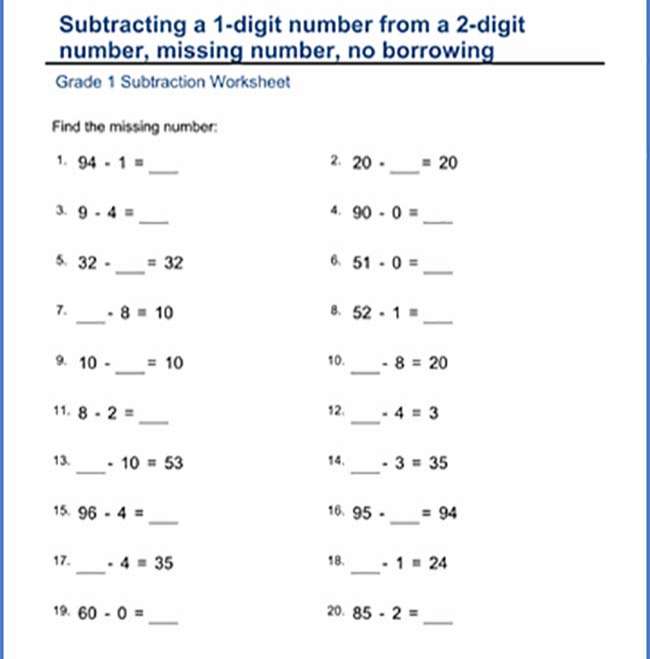
- This simple activity allows kids to explore subtraction as inverse of addition. In addition, they were collecting things to form a larger group and here they shall try to split a larger group in to smaller sub-groups.
For example, they can clearly see that 5 + 2 =7 but now they need to visualize 7- 5 =?
- Identifying the missing addend can also be looked through this fun math activity. This shall help children to see relation between addition and subtraction. This activity gives lot of practice with math problems too.
Try SplashLearn for Free
5 Strategies for Teaching Subtraction in 1st Grade
Raise your hand if you feel like you have mastered teaching addition strategies? But…when it comes to subtraction, you could use some help. If you can relate to this question, you are definitely not alone. Subtraction is a tricky concept for many of our students. And, it can often be a bit harder to teach! Like with addition, we want our students to become fluent with these math facts, but this requires time and practice. If you are searching for strategies to teach addition, be sure to check out this post. And, if you are ready to learn some strategies to help you teach subtraction like a rockstar, then keep scrolling!
If you are searching for strategies to teach addition, be sure to check out this post. And, if you are ready to learn some strategies to help you teach subtraction like a rockstar, then keep scrolling!
Like with many other concepts we teach, there is never a one-size-fits-all approach. What works for one student might not necessarily work for another, so equipping our students with many strategies and approaches can help them better grasp and understand subtraction.
Anchor Charts
I love anchor charts. They are not only great learning tools for students, but they also allow your students to be actively involved with what they are learning. As I teach a lesson, my students help me create the anchor chart with important content and strategies. And, then the anchor chart will contain the various subtraction strategies, and my students can refer to the anchor chart if they need some guidance.
Some ideas for a subtraction anchor chart would be:
-use manipulatives
-count backward on number line
-count up from the smaller subtrahend
Relate to Addition
I mentioned that teaching addition is just a bit easier for me, and I know many of you can relate.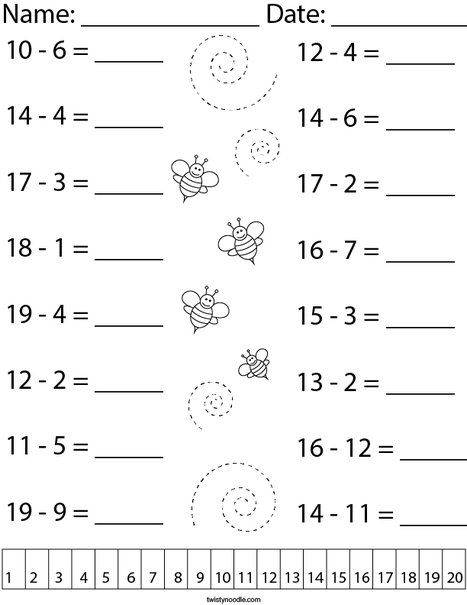 I am guilty of spending way more time teaching addition but, the good news is that many of the addition strategies that we use can also be applied to subtraction. For instance, in addition, we teach our students counting on. And, with subtraction, we can focus on counting back. So, think of the strategies that you find that your students do well with when it comes to addition, and work them in a way to use with subtraction.
I am guilty of spending way more time teaching addition but, the good news is that many of the addition strategies that we use can also be applied to subtraction. For instance, in addition, we teach our students counting on. And, with subtraction, we can focus on counting back. So, think of the strategies that you find that your students do well with when it comes to addition, and work them in a way to use with subtraction.
Manipulatives
Counting bears, snap cubes, and erasers are just a few of my must-haves to use with subtraction. Using manipulatives and counters is one of the first strategies I always use to teach subtraction. Manipulatives allow students to see what it means to take something away and visually see subtraction happening. I let my students use manipulatives with math centers, worksheets, and games. In my opinion, manipulatives are the most concrete strategy for helping students truly understand subtracting concepts. There are so many great ways to use manipulatives..gif) Many of my students are visual learners, so it’s essential that they need manipulatives to assist them with subtraction in the beginning stages.
Many of my students are visual learners, so it’s essential that they need manipulatives to assist them with subtraction in the beginning stages.
Visualizing
And speaking of visual learners… Visualization is another strategy that plays a huge role in students building fluency. At the same time, manipulatives are a great hands-on way to teach subtraction. But, I mean allowing students to truly see subtraction happening. A human number line is a fun and interactive way for students to learn visually. And, it’s a great team-building activity. I also encourage my students to draw, especially when doing story problems. When they draw out the problem, they can solve the subtraction problems better. Number lines are a great tool to help students visually solve the problem as well.
Games
After teaching various strategies and using anchor charts, it’s time to put our knowledge to work which is where games come in. Every single time you teach a new strategy, practice with a game.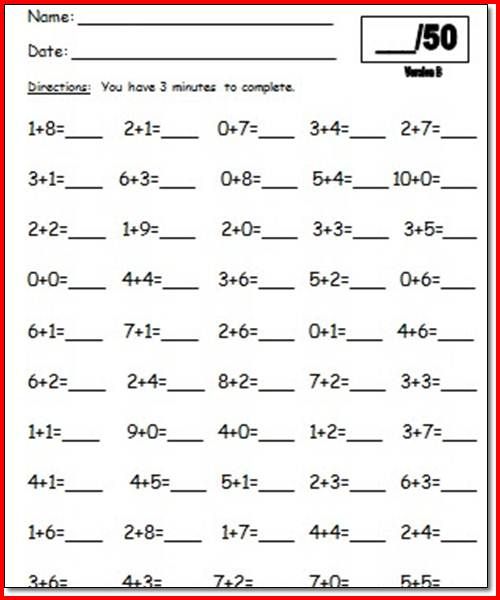 Games allow students to not only have fun with the learned material but also allows them time to practice and gain experience. Games invite students to try out the strategies but in a way that making a mistake is ok, and in turn, their confidence builds.
Games allow students to not only have fun with the learned material but also allows them time to practice and gain experience. Games invite students to try out the strategies but in a way that making a mistake is ok, and in turn, their confidence builds.
One of the most critical aspects of teaching different subtraction strategies is to make sure your students are able to clearly explain HOW they got their answer. This is why I love number talks. So, after introducing a specific strategy, make sure you bring it into your number talks so that your students have hands-on practice explaining their logic.
As always, my best piece of advice is practice, practice, and practice. While one strategy may work, another one might need a bit more practice for your students to master it. What is your favorite method for teaching subtraction?
Examples for addition and subtraction within 10 and 20 (math simulator for grade 1)
- Category: Elementary School
The very first examples that a child gets acquainted with before school are addition and subtraction.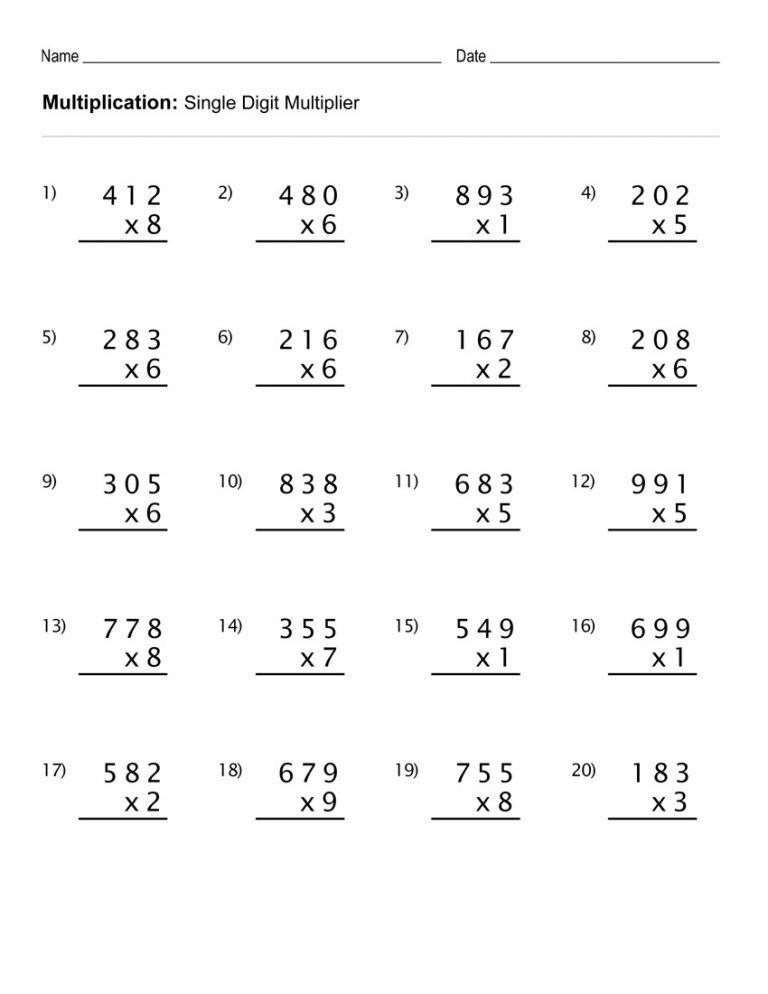 It is not so difficult to count the animals in the picture and, crossing out the extra ones, count the rest. Or shift the counting sticks, and then count them. But for a child it is somewhat more difficult to operate with bare numbers. That is why it takes practice and more practice. Do not stop studying with your child in the summer, because over the summer the school curriculum simply disappears from a small head and it takes a long time to catch up on lost knowledge. nine0009
It is not so difficult to count the animals in the picture and, crossing out the extra ones, count the rest. Or shift the counting sticks, and then count them. But for a child it is somewhat more difficult to operate with bare numbers. That is why it takes practice and more practice. Do not stop studying with your child in the summer, because over the summer the school curriculum simply disappears from a small head and it takes a long time to catch up on lost knowledge. nine0009
If your child is a first-grader or just going to the first grade, start by repeating the composition of the number by house. And now we can take examples. In fact, addition and subtraction within ten is the first practical application by a child of knowing the composition of a number.
Click on the pictures and open the simulator in maximum magnification, then you can download the image to your computer and print it in good quality.
It is possible to cut A4 in half and get 2 worksheets if you want to reduce the load on the child, or let them decide one column a day if you decide to work out in the summer. nine0009
nine0009
We solve the column, celebrate successes: cloud - not very well solved, smiley - good, sun - wonderful!
Addition and subtraction within 10
And now scatter!
Examples for addition and subtraction within 20
By the time the child starts studying this topic of mathematics, he should know very well, by heart, the composition of the numbers of the first ten. If the child has not mastered the composition of numbers, it will be difficult for him in further calculations. Therefore, constantly return to the topic of the composition of numbers within 10 until the first grader masters it to automatism. Also, a first grader should know what the decimal (bit) composition of numbers means. In math class, the teacher says that 10 is, in other words, 1 ten, so the number 12 consists of 1 ten and 2 units. In addition, units are added to units. It is on the knowledge of the decimal composition of numbers that the methods of addition and subtraction within 20 9 are based0013 without jumping through ten .
Examples for printing without crossing ten mixed up:
Addition and subtraction within 20 with transition through ten responsibly approach the study of this topic with the child.
Examples with the transition through a dozen (half of the sheet is addition, half is subtraction, the sheet can also be printed in A4 format and cut in half into 2 tasks):
We hope that our funny pictures with examples will inspire children to solve them with pleasure :)
We also have a great online math simulator! Parents do not need to print and check anything, we will do all this for you completely free of charge! Choose a mode and go >>
- Back
- Forward
tasks for counting and logic
Actual
Tables- How to teach a child to mathematical account
- Tasks for adoption for first -graders
- Option 1
- Option 2
- Option 4
- Tasks for first -graders
- Option 1
- Option 2
- Option 2
- Option 2
- Option 2
- Option 2
- Option 2
- Option Option 3
- Option 4
- Comparison tasks for first graders
- Logic tasks for first graders
- Instead of a conclusion
Sending a child to first grade, parents always dream that their child will be an excellent student and receive only the highest marks in all subjects.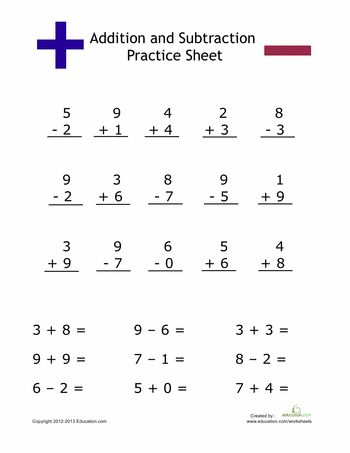 And if it is not at all difficult to teach a child to read, then it is not always easy for children to understand and solve mathematical problems. In order for a first-grader to succeed in mathematics at school, parents either hire a tutor, which is not always financially justified, or try to work with their children on their own. In this material, we will tell you how to pull up a first-grader in mathematics at home, talk about different types of problems and methods for solving them. nine0009
And if it is not at all difficult to teach a child to read, then it is not always easy for children to understand and solve mathematical problems. In order for a first-grader to succeed in mathematics at school, parents either hire a tutor, which is not always financially justified, or try to work with their children on their own. In this material, we will tell you how to pull up a first-grader in mathematics at home, talk about different types of problems and methods for solving them. nine0009
How to teach a child to count
Parents of first-graders should remember that at the age of 5-7 years, abstract thinking is still poorly developed in children. Remember the tale of Pinocchio, when he counted the apples that “Someone” allegedly took. Similarly, a 5–7-year-old child is not yet able to imagine the condition of the problem.
It is best to use visual aids that the child can see and touch. These can be counting sticks, cubes or pictures cut out of cardboard (for example, a set of cardboard hedgehogs, flowers, leaves, etc.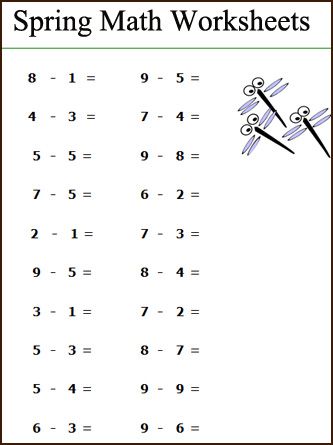 ). Lay out in front of the child the entire condition of the task from visual materials: there was so much, so much was added or taken away. So it will be easier for him to understand the condition of the problem and it will be easier to find its solution. nine0009
). Lay out in front of the child the entire condition of the task from visual materials: there was so much, so much was added or taken away. So it will be easier for him to understand the condition of the problem and it will be easier to find its solution. nine0009
Another important point in teaching children is that the child must learn to distinguish tasks from each other by type. To do this, you can target it to some keywords. For example, if the task mentions the words "added", "brought", "arrived", "ran" and others denoting joining, then this is an addition problem.
Understanding what type a particular problem belongs to, the child will learn to determine the required solution algorithm and successfully cope with the task. nine0009
Addition problems for first graders
As already mentioned, addition problems have a common feature - attachment. Another sign of addition tasks is the phrase “how much” in the task question.
The child must learn to clearly understand that if there is something added to the condition, then he needs to add up the available numbers.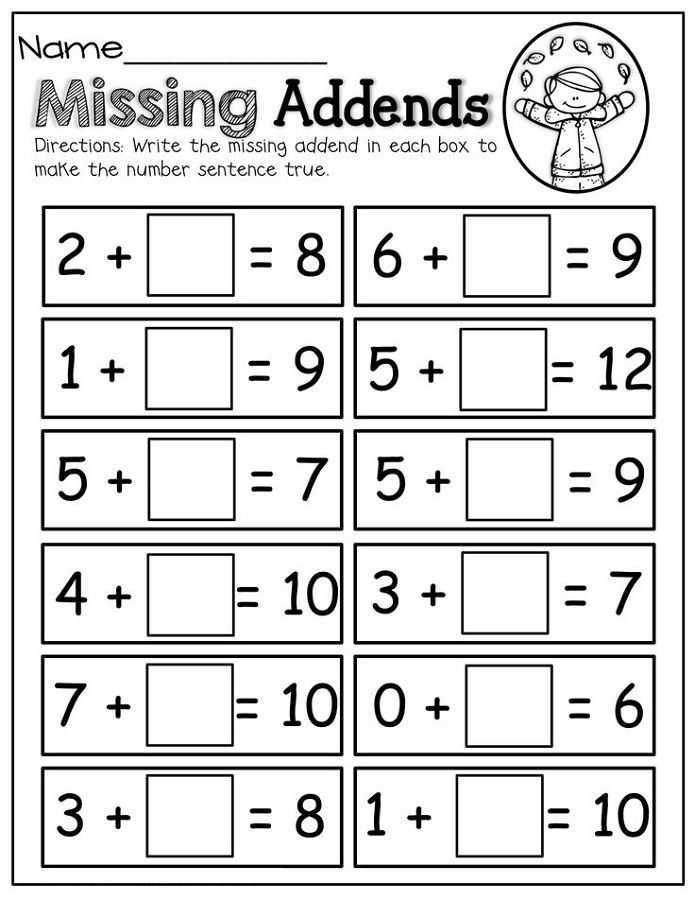 The child must understand what the first term, the second term and the sum are, and be able to find them in the task condition. nine0009
The child must understand what the first term, the second term and the sum are, and be able to find them in the task condition. nine0009
In order for a child to master mental counting well, he needs to regularly practice mental counting. If you are on vacation, at least once a day, ask him examples to develop memory. You can even study on the way to school or in the section.
Five to ten examples daily will not tire a first-grader too much, but will bring many benefits for his further studies.
Below are addition problems for first graders. For convenience, we have divided them into options, so that when studying at home, you can solve already completed tasks with your child. nine0009
Option 1
- Natasha read 5 books during the holidays, and Katya read 4 books. How many books did the children read together during the holidays?
- There were 6 apples on one branch of the apple tree, and 7 on the other. How many apples were there on both branches of the apple tree?
- There are potted flowers on the window in the classroom.
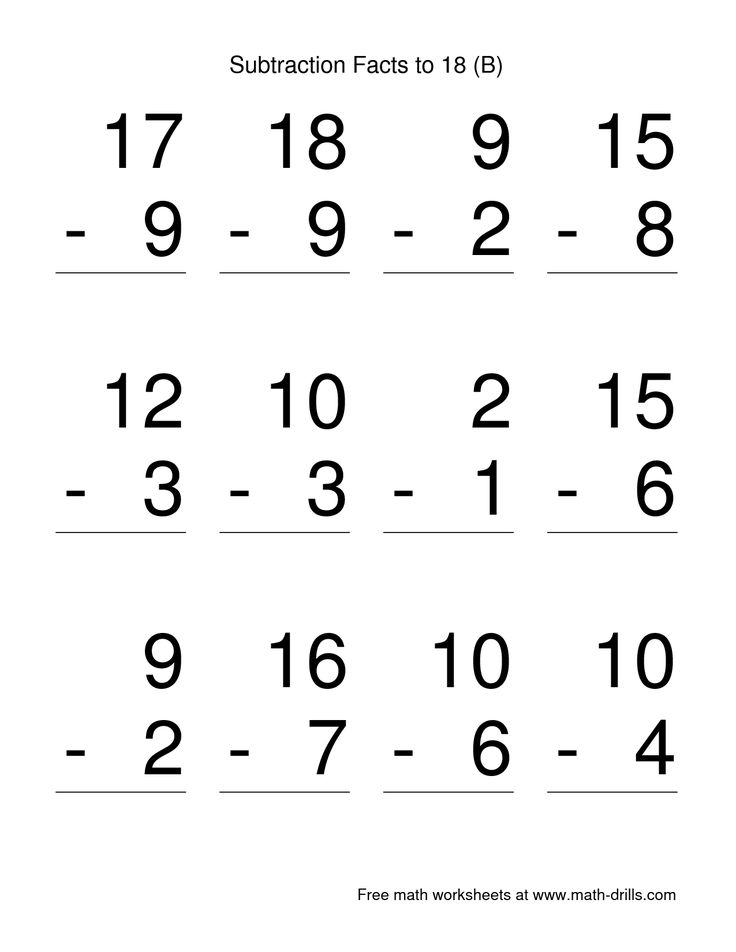 The first window has 2 flowers, the second has 3 flowers, and the third has 1 flower. How many flowers are in the class?
The first window has 2 flowers, the second has 3 flowers, and the third has 1 flower. How many flowers are in the class? - Alyosha's family has 2 boys and 1 girl. Tanya's family has 1 girl and 1 boy. Serezha has 2 boys in the family, and Katya has only 1 girl. How many girls live in the families of all children? And how many boys? nine0065
- According to the results of assessments for the 1st quarter in the 1-A class, 10 excellent students, 14 good students and 2 three students. In the 1-B grade - 8 excellent students, 12 good students and 3 three students. And in 1-B - 11 excellent students, 11 good students and 4 three students. How many excellent students, good students and three students in the entire parallel of the first classes?
Option 2
- Natasha is 8 years old, how old will she be in 3 years? In 4 years, in 10 years?
- In the stationery store, Nastya liked the felt-tip pens for 18 rubles. She has 10 rubles, 5 rubles, 2 rubles and 1 ruble.
 Will the girl have enough money to buy? nine0065
Will the girl have enough money to buy? nine0065 - 6 girls and 12 boys went for a walk. How many children went out for a walk?
- Sasha has a pack of counting sticks. Of these, 10 are red, 8 are blue and 12 are yellow. How many sticks are in the pack?
- 4 girlfriends and 5 friends came to Polina's birthday party. How many children will sit at the festive table? (here it is important that the child does not forget to count Polina herself, the answer in the problem is 10 children).
Variant 3
- Children came to the park and saw birds swimming on the lake: 8 swans and 12 ducks. How many birds were swimming in the lake? nine0065
- Children were planting saplings at school. Petya planted 2 seedlings, Anton planted 3, Natasha and Katya planted 2 seedlings. How many seedlings did the children plant in total?
- There were sweets in a box on the table. Masha ate 5 candies, Alena - 3 candies, Nastya - 6 candies, and Kolya ate 6 candies and the box was empty.
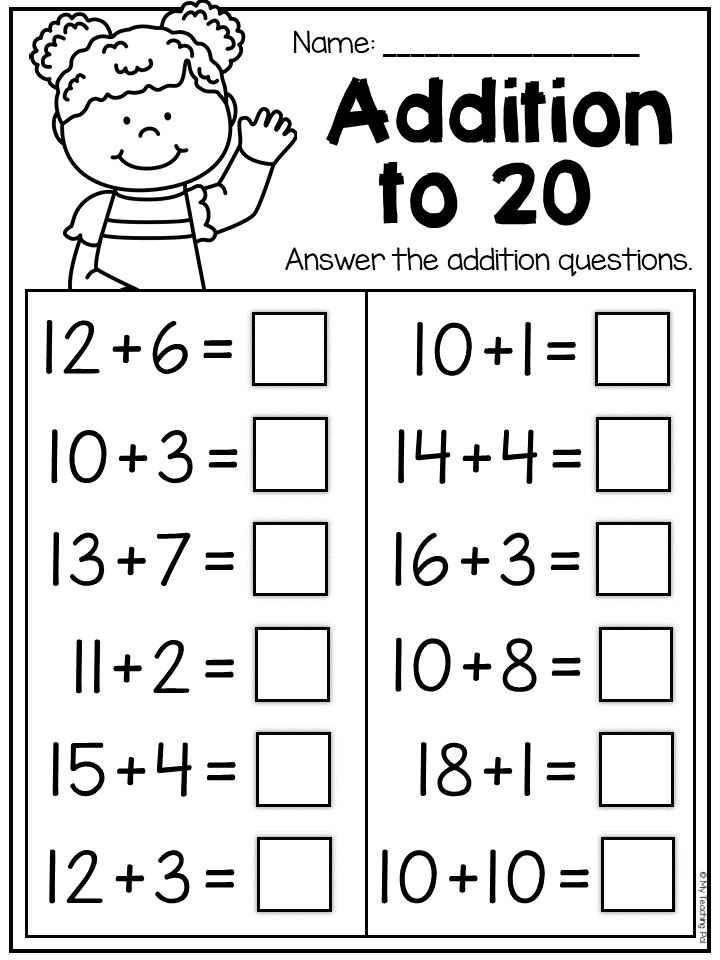 How many sweets were in the box from the very beginning?
How many sweets were in the box from the very beginning? - There are 20 postcards in Marina's collection. Yulia also has 20 postcards. How many postcards do girls have?
- Seva had 20 stamps, he was presented with 4 more stamps. How many stamps did Seva have in total? nine0065
Option 4
- Mom planted 20 cucumber bushes and 17 tomato bushes. How many plant bushes did mom plant in total? On Monday, 8 tables were brought to the canteen, on Tuesday - 7 tables, and on Thursday - 10 more. How many tables did the canteen receive in a week?
- Pasha and dad went camping. On the first day they walked 12 km. In the second - 10 km, in the third - 8, and in the fourth - 11. What path did dad and Pasha cover?
- The zoo has 12 monkeys, 8 tigers, 2 elephants, 6 bears and 4 raccoons. How many animals are in the zoo? nine0065
Important! If every day you solve one version of addition tasks with a child, then on the control tests he will show brilliant results.
- There are 13 boys and 12 girls in Grade 1-A. There are 12 boys and 15 girls in grade 1-B, and 10 boys and 12 girls in grade 1-C. How many boys and how many girls are there in all first grades?
Subtraction tasks for first graders
Subtraction tasks also have their own characteristics and features. In the condition, you can always find some of the characteristic phrases: “how much is left”, “there were so many, of them ...”, “there were so many, so many left / flew away / ran away / deteriorated, etc.” and others. Here it is also important to understand what the first term, the second term and the sum are, to be able to find them in the task condition, because subtraction problems are the inverse of addition. And the concepts here are slightly different: reduced, subtracted, difference. nine0009
Below are subtraction problems for first graders. For convenience, we also divided them into options so that when doing homework, children can solve already completed tasks.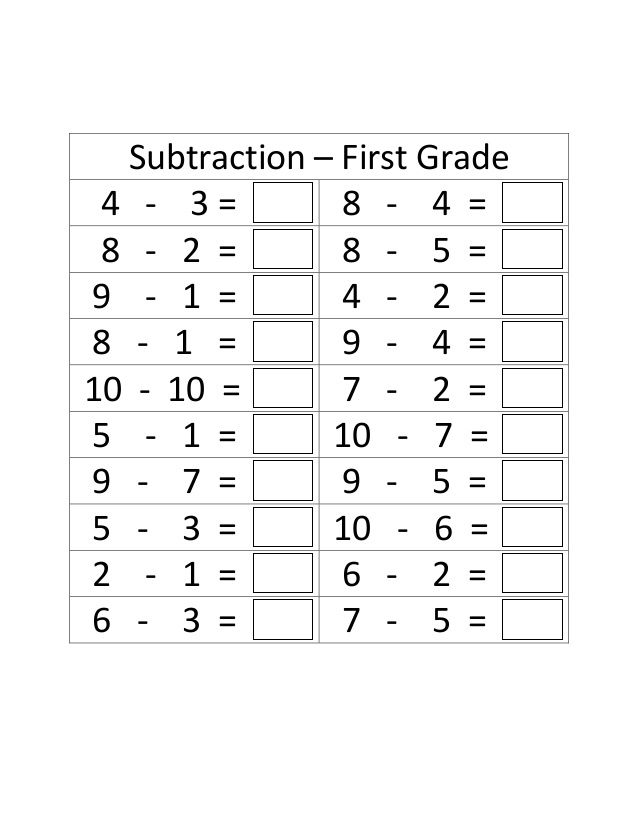
Here there are tasks both for finding the remainder (“how much is left”) and for decreasing (“by how much the number has changed”).
Option 1
- Andrei lives on the 7th floor, and Alena 3 floors below. What floor does Alena live on?
- Volodya has 17 cars, but Sasha has none. Volodya gave Sasha 8 cars. How much does he have left? nine0065
- Natasha is 12 years old, and her brother Seryozha is 7 years younger. How old is Seryozha?
- There were 10 apple trees in the garden, and 4 less pear trees. How many pears grew in the garden?
- On the first day Mila read 24 pages in the book, and on the second day she read 3 less. How many pages did Mila read on the second day?
Option 2
- Children receive books in the school library. Petya took 8 books, Alyosha took 2 books less than Petya, and Vanya took 3 books more than Alyosha. How many books did each boy take? How many books did they take together? nine0065
- There were 25 berries in a vase on the table.
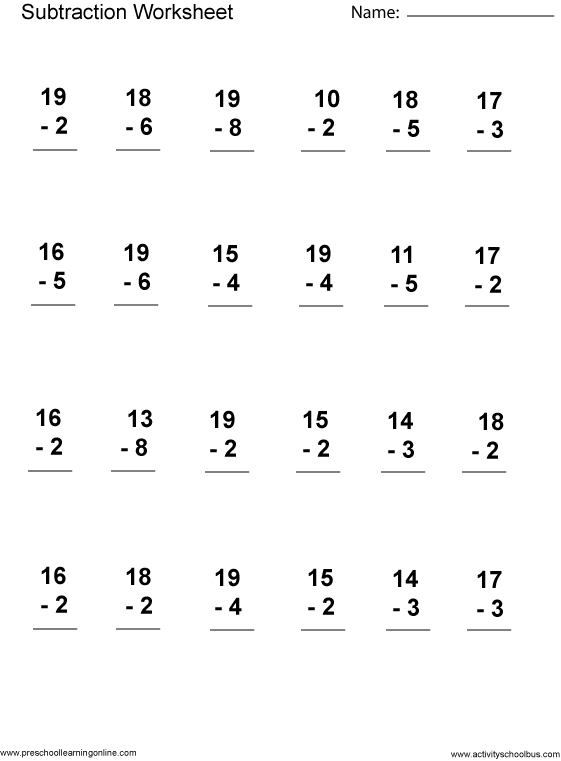 Marina ate 4 berries, Alice ate 6 berries, Mila ate 3 berries, and Katya finished the rest of the berries. How many berries did Marina and Alice eat? Mila and Katya How many berries did Katya eat?
Marina ate 4 berries, Alice ate 6 berries, Mila ate 3 berries, and Katya finished the rest of the berries. How many berries did Marina and Alice eat? Mila and Katya How many berries did Katya eat? - There were 10 plates on the table and 6 less in the sink. How many dishes were in the sink?
- Serezha is 15 years old, his sister Larisa is 4 years younger. And the youngest brother Boris is 7 years younger than Larisa. How old are Larisa and Boris?
- Mom planted 30 cucumber bushes, 17 bushes sprouted. How many cucumber bushes were lost in total? nine0065
Option 3
- The children went to the forest for mushrooms. Dima found 10 russula and 7 white mushrooms. Tanya found 3 less russula and 2 less white ones. How many and what kind of mushrooms did Tanya find?
- The first house has 12 entrances, the second house has 4 entrances less than the first one. And in the third house there are 6 entrances less than in the first. How many entrances are in each of the houses?
- There are 23 apples in the first basket, and 11 less apples in the second.
 How many apples are in both baskets? nine0065
How many apples are in both baskets? nine0065 - 12 girls participated in the performance, and 3 less boys. How many boys were in the play?
- There are 15 roses in one vase and 8 less in another. How many roses are in the second vase?
Option 4
- Sweets cost 30 rubles, and bread is 15 rubles cheaper. How much does bread cost?
- Grandmother baked pies. With potatoes 30 pieces, with jam 10 less than with potatoes, and with cabbage 5 less than with potatoes. How many and what kind of pies did grandma bake? nine0065
- There were 20 men on the bus. There were 5 fewer women than men, and 7 fewer children than women. How many people were on the bus in total?
- Children receive books in the school library. Sasha took 5 books, Misha took 2 books less than Sasha, and Serezha took 2 books more than Misha. How many books did each boy take? How many books did they take together?
- 20 buckets of water were used to water the garden.
 12 buckets went to the beds with cabbage. How much went to the beds with carrots? nine0065
12 buckets went to the beds with cabbage. How much went to the beds with carrots? nine0065
Comparison tasks for first graders
- Comparison tasks are aimed at finding any number that is less or more than the original. In principle, to some extent they can be attributed to addition or subtraction tasks, so we decided not to describe these tasks by options, but to give several similar examples:
- There were 10 cats sitting on the roof: 7 black and 3 grey. How many more black cats than gray ones?
- In the village, my grandmother has chickens and ducks. There are 18 chickens and 15 ducks. How many more chickens than ducks. nine0065
- Tanya has 3 dolls, and Dina has 4 more. How many dolls does Dina have? How many dolls does Tanya have less?
- Marina is 14 years old and Misha is 9. How many years is Marina older than Misha?
- There are 8 cars in the garage. Of these, 3 trucks and 5 cars. How many fewer trucks than cars?
- Dima was presented with gifts for his birthday.
First, mom and dad gave 2 gifts, then friends brought 5 gifts. How many more gifts did Dima have?
- On the first day of vacation, Yura solved 5 problems, on the second - 7, and on the third - 2. How many more problems did Yura solve on the second day? nine0065
- How many problems less than the first did Yura solve on the third day? And how many fewer problems did he solve on the third day than on the second?
- Sonya had 3 oranges and 10 apples. How many more apples than oranges?
- Olya has 3 hares and 2 squirrels. Mila has 5 dolls and 1 bear. Who has more toys and by how many?
- Cows were grazing in the meadow. 7 goats came to them and in total there were 15 animals in the meadow. How many cows were there?
Logic tasks for first graders
Articles with recommendations from teachers and lists of exercises and tasks have already been devoted to the development of logical thinking. Here we present several logical tasks that will allow not only to develop, but also to train the logic of first graders.
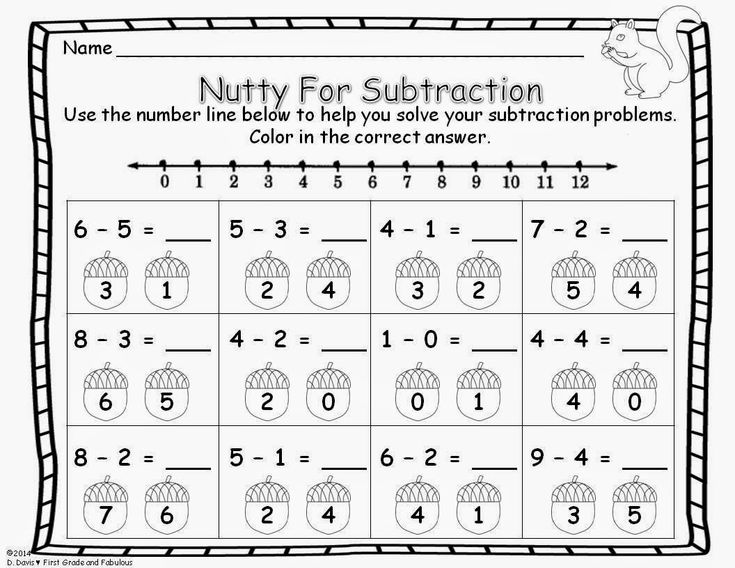
- Which is easier? A kilogram of cotton wool or a kilogram of nails? Tea, compote and cocoa were poured into a glass, mug and cup. There is no cocoa in the mug. There is no cocoa in the cup, and no compote. What was poured into what?
- How many fingers are on 3 hands? nine0065
- How many paws do 4 cats have?
- How many hands do 10 children have?
- Lena and Misha saw 2 ships in the sea. How many ships did each of the children see?
- Kitten tails sticking out from under the bed. How many kittens are there if 7 tails are visible?
- Dogs hid behind the fence. You can see 12 paws from under the fence, how many dogs are behind the fence?
- There are 5 peaches and 8 pears on the table. How many apples and plums will there be in total?
- There are 2 glasses of milk on the table. Petya drank the milk and put the camp on the table. How many glasses are on the table? nine0065
- Vanya left the school. 3 girls walked towards him.
How many children left school?
- Seven first graders went from home to school: Petya, Masha, Liza, Grisha, Tolya, Misha and Larisa, and 4 second graders: Serezha, Tanya, Mila and Vanya. How many girls went to school?
- To get into the theater 2 daughters and 2 mothers needed 3 tickets. How could this happen?
- Misha is 2 years older than Lena. How much older will he be than Len in 5 years?
- Lena and Milana planted 10 flowers each and finished the work at the same time. Milana started work earlier. Which of the girls worked slower? nine0065
Instead of a conclusion
The mathematical development of first-graders is of great importance in their education. By solving examples and problems, the child acquires new experience, knowledge and skills. Learns to think logically and mathematically, find solutions from various situations, more successfully master related sciences in further studies.
Children's progress should not be left to chance, and every effort should be made to help them in this difficult matter, like studying in the first grade.